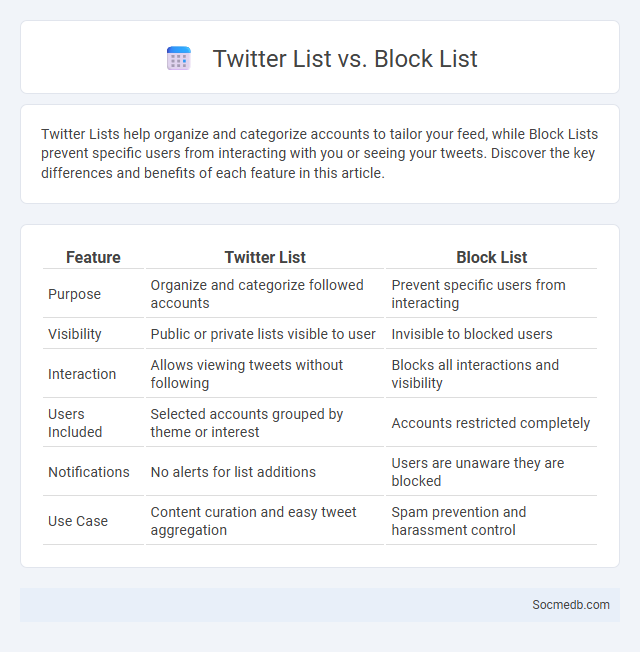
Photo illustration: Twitter List vs Block List
Twitter Lists help organize and categorize accounts to tailor your feed, while Block Lists prevent specific users from interacting with you or seeing your tweets. Discover the key differences and benefits of each feature in this article.
Table of Comparison
| Feature | Twitter List | Block List |
|---|---|---|
| Purpose | Organize and categorize followed accounts | Prevent specific users from interacting |
| Visibility | Public or private lists visible to user | Invisible to blocked users |
| Interaction | Allows viewing tweets without following | Blocks all interactions and visibility |
| Users Included | Selected accounts grouped by theme or interest | Accounts restricted completely |
| Notifications | No alerts for list additions | Users are unaware they are blocked |
| Use Case | Content curation and easy tweet aggregation | Spam prevention and harassment control |
Understanding Twitter Lists: Definition and Purpose
Twitter Lists are curated groups of Twitter accounts that help you organize and filter content based on specific interests or topics. They enable you to monitor conversations and updates from selected users without the clutter of your main timeline, enhancing your social media experience. Your engagement becomes more focused as you can easily track industry experts, friends, or news sources relevant to your goals.
What Is a Block List on Twitter?
A block list on Twitter is a feature that allows users to prevent specific accounts from interacting with their profile, tweets, and messages. By adding accounts to a block list, users restrict unwanted communication and enhance their online privacy and security. This tool is essential for managing harassment, spam, and ensuring a controlled social media experience.
Key Differences: Twitter List vs Block List
Twitter Lists organize users into categorized groups, enabling streamlined content curation and targeted engagement by following select accounts without needing to follow them. Block Lists, on the other hand, prevent specific users from interacting with your account, enhancing privacy and controlling unwanted communication. Understanding these functions helps optimize social media management by balancing content discovery with personal security.
When to Use a Twitter List
Using a Twitter List helps you organize and prioritize your feed by grouping accounts into categories based on your interests or industry. This tool is ideal for tracking competitors, monitoring client conversations, or staying updated on specific topics without distractions from unrelated tweets. You can boost your social media strategy by regularly engaging with curated content tailored to Your professional goals.
Best Use Cases for Twitter Block List
Twitter block lists are essential for managing your online experience by filtering out spam accounts, trolls, and harmful content, ensuring a safer and more relevant feed. Best use cases include protecting your brand reputation from negative interactions, maintaining a positive community for your followers, and streamlining content moderation efforts. Leveraging block lists helps you save time by automatically excluding disruptive users and focusing on meaningful engagement.
Privacy and Visibility: Lists vs Block Lists
Privacy and visibility settings on social media platforms impact how users control their content and interactions. Lists allow selective sharing by grouping trusted contacts, enhancing personalized visibility without broad exposure, while block lists prevent specific users from accessing or interacting with profiles entirely, ensuring stronger privacy but with less nuanced control. Effective use of both features balances social engagement with safeguarding personal information from unwanted viewers.
How to Create and Manage Twitter Lists
Creating and managing Twitter Lists involves organizing users into curated groups to streamline content consumption and enhance engagement. Users can create lists by navigating to the Lists section, clicking "Create new list," naming it, adding a description, and setting privacy options. Effective management includes regularly updating list members, categorizing by themes or interests, and monitoring these lists to stay informed on specific topics or communities.
Steps to Set Up and Maintain Block Lists
To set up and maintain block lists on social media, access the privacy or security settings of your account where user management options are available. Add specific usernames or profiles that you want to restrict from interacting with your content, ensuring control over unwanted communications. Regularly review and update the block list to manage new contacts or remove users who no longer pose a threat, enhancing your online safety.
Pros and Cons: Twitter List vs Block List
Twitter List enables users to organize accounts into curated groups for streamlined content consumption, enhancing focus and reducing timeline clutter. In contrast, Block List prevents interactions from blocked accounts, improving user safety and minimizing exposure to unwanted content but can limit networking opportunities. Balancing these tools optimizes social media experience by combining content curation with personal boundary enforcement.
Choosing the Right Tool: Which List Works Best for You?
Choosing the right social media tool depends on your specific goals, whether it's increasing brand awareness, driving website traffic, or engaging with your audience. Platforms like Instagram excel for visual content and younger demographics, while LinkedIn is ideal for B2B networking and professional content. Analyzing your target audience's preferences and the tool's features ensures maximum impact for your social media strategy.
 socmedb.com
socmedb.com